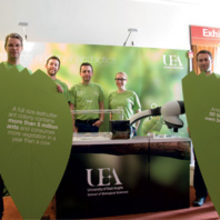Outreach: Royal Society Summer Science Exhibition 2014
Issue: Water
17 November 2014 article

Leafcutter ants and their antibiotics
My research group had the privilege of presenting our research at the prestigious Royal Society Summer Science Exhibition 2014. This week-long event is completely free to schools and the general public and is hosted in the beautiful Royal Society building, just off The Mall and around the corner from Trafalgar Square.
Our display was entitled Leafcutter ants and their antibiotics and included a live leafcutter ant colony, an antibiotic discovery zone, as well as an animation explaining the research and a 3D leafcutter ant which you can see on the University of East Anglia website.
We were one of about 20 exhibits selected from more than 100 applications, only two of which were related to microbiology. Leafcutter ants and their close relatives are amazing microbiologists and have been culturing a fungus as the sole food source for their colonies for more than 50 million years. They feed this fungus leaf material that they cut from the rainforest canopies in South and Central America and they tend their fungus gardens just like human farmers tend their crops. They groom and weed out other unwanted microbes and protect themselves and their fungus against diseases by growing antibiotic-producing bacteria on their cuticles. They feed these bacteria through specialised glands and in return the bacteria provide them with antibiotics to use as weed killers in their fungus gardens. Remarkably, they use the same type of soil bacteria – known as actinomycetes – that provide us with 80% of the antibiotics used in human medicine but the ants have been doing it for much, much longer and have no problems with drug resistance. We have been exploring this unique environmental niche for novel antibiotics and also using leafcutter ants as an experimental model to try and understand how beneficial microbiomes form. The ants have also provided us with a fantastic outreach tool for explaining how antibiotics are used in nature.
We had an absolutely amazing time at the Royal Society and the response from the general public was terrific. It was inspiring to meet such enthusiastic and engaged members of the public, with around 15,000 visitors attending the event. We were also very lucky to be in London the same week that David Cameron made his announcement about the dire need for new antibiotics. In possibly the strangest night of my life, I was chauffeured to BBC Broadcasting House to talk to Eddie Mair about antibiotics on the Radio 4 PM programme and then chauffeured back again with just enough time to get into my tuxedo and dash to the VIP evening soirée at the Royal Society. Things got even more surreal the next day when a film crew from the BBC’s The One Show turned up to make a film about our leafcutter ant exhibit. It was great to share our love for microbiology, and I hope that more Society members will apply to have exhibits at Summer Science in 2015.
I’d like to thank everyone that visited us there, the amazing team of scientists that worked hard all week on our stand, and everyone else who offered support in getting the exhibit together. The Society, and in particular Benjamin Thompson, Theresa Hudson and Dariel Burdass, also deserves very special thanks for very generously helping to fund and support the exhibit and for providing lots of great microbiology materials for us to give away to the general public. The next public appearance of our leafcutter ants will be at the BBSRC Great British Bioscience Festival in November at the Museum Gardens in London’s Bethnal Green. We’ll be part of the Antibiotic Hunters exhibition with our collaborators at the John Innes Centre in Norwich.
Matt Hutchings
University of East Anglia
[email protected]
Image: Matt (left) with members of the group at the University of East Anglia stand..
